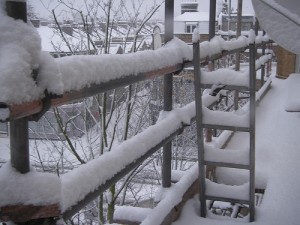Winter can be a dangerous time for people working in the construction industry. Scaffolding, in particular, can become hazardous when subjected to unfavorable elements like freezing rain, snow, and ice.
While the weather conditions in the UK this winter have been relatively mild so far, January 2016 has already seen two major accidents involving scaffolding take place.
The first is a particularly tragic story, as the victim in question died after falling sixty feet from scaffolding erected at the rear of the Calderdale Royal Hospital in Halifax, West Yorkshire. The Health and Safety Executive is still trying to determine the cause of the tragedy, although eyewitnesses say the victim was working on-site and “brought all the scaffolding down with him” when he fell.
The second accident occurred on a building site in Southampton when a piece of scaffolding fell on a construction worker in his 40s. At the time of writing, the victim is being treated for a lower back injury in a local hospital, which is not thought to be serious. An internal investigation into the incident is being conducted, but a Crest Nicholson spokesman suggests it was “a freak accident” involving a scaffolding pole that “managed to roll through a hole in the upper floor” and hit the worker on the floor below.
Scaffolding safety tips for winter
While construction sites should be routinely checked and safety procedures adhered to all-year-round, there are extra safeguards that you can put in place to help keep your workforce as safe as possible during the winter months.
Always begin the working day by examining the site to ensure that all snow and ice has been removed from areas (including any surfaces) where workers and members of the public may be passing through. The inspection process doesn’t end there as regular checks must be performed throughout the day to check for any ice build-up on access equipment or scaffolding. Snow and ice can add extra weight to scaffold equipment, and this must be taken into consideration before allowing any workers to use it.
Make sure your scaffolds’ wheels are locked in position and that guardrails are installed to help prevent slips, trips, and falls.
Construction workers are advised to wear non-slip footwear but not the kind with spikes, as these can cause injuries in the event of an accident.
You can find more guidance about how to erect, dismantle, alter, inspect, and use scaffolds on the Health and Safety Executive’s website. PASMA also runs a variety of industry-standard training courses for managers and construction workers who work at height and use low-level access equipment.
Buy or hire access equipment from Zig Zag Access
If your company operates in the Leeds or West Yorkshire area, you can turn to Zig Zag Access for all your scaffolding and access equipment needs. We sell AND hire a broad range of products that you can browse online, and should you need further assistance, a quick call to our experts or a visit to our Leeds depot is all it takes. To make things even simpler, we invite you to open a trade account with us so that you can quickly and easily advise us of your current and upcoming requirements.


